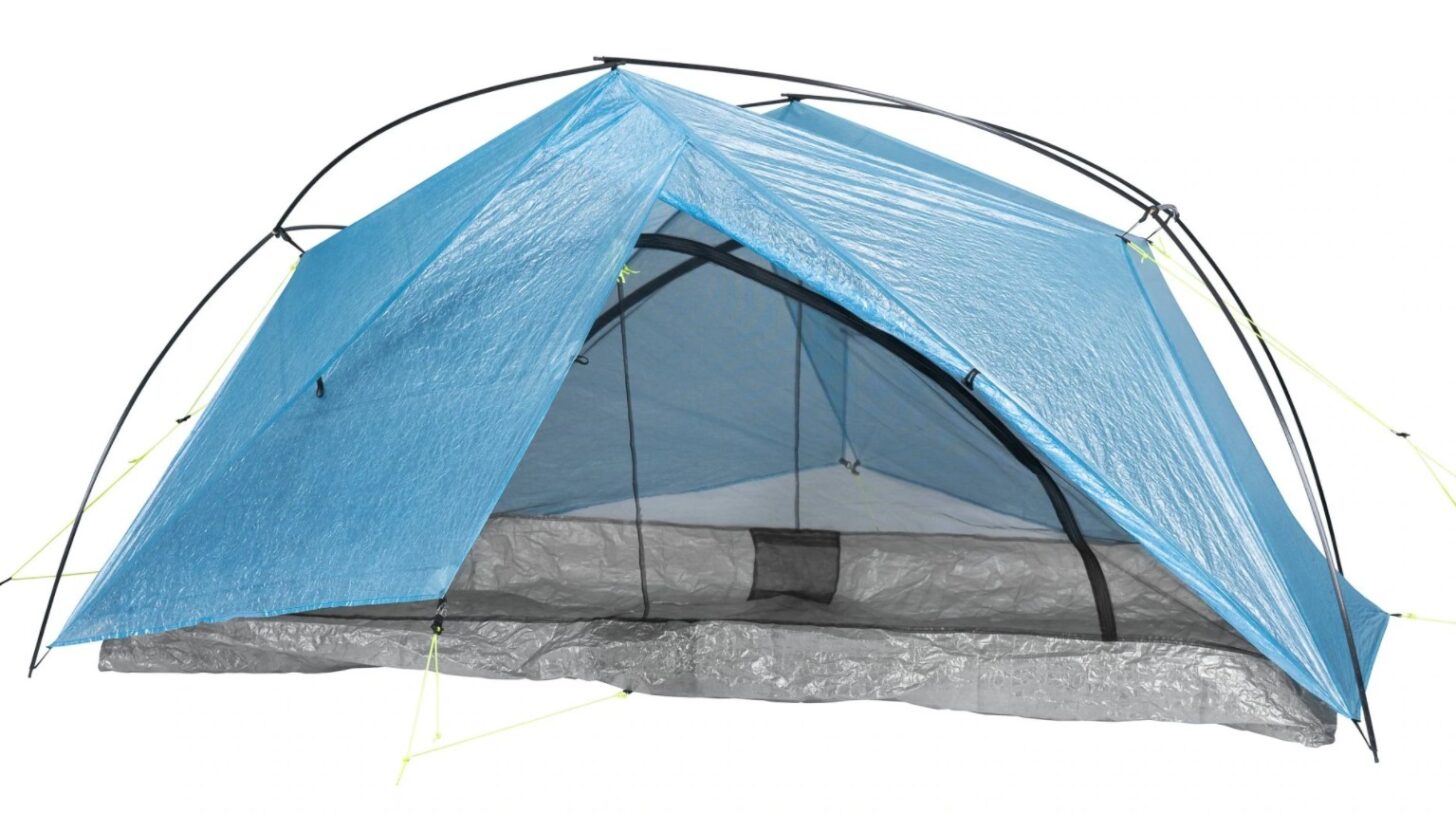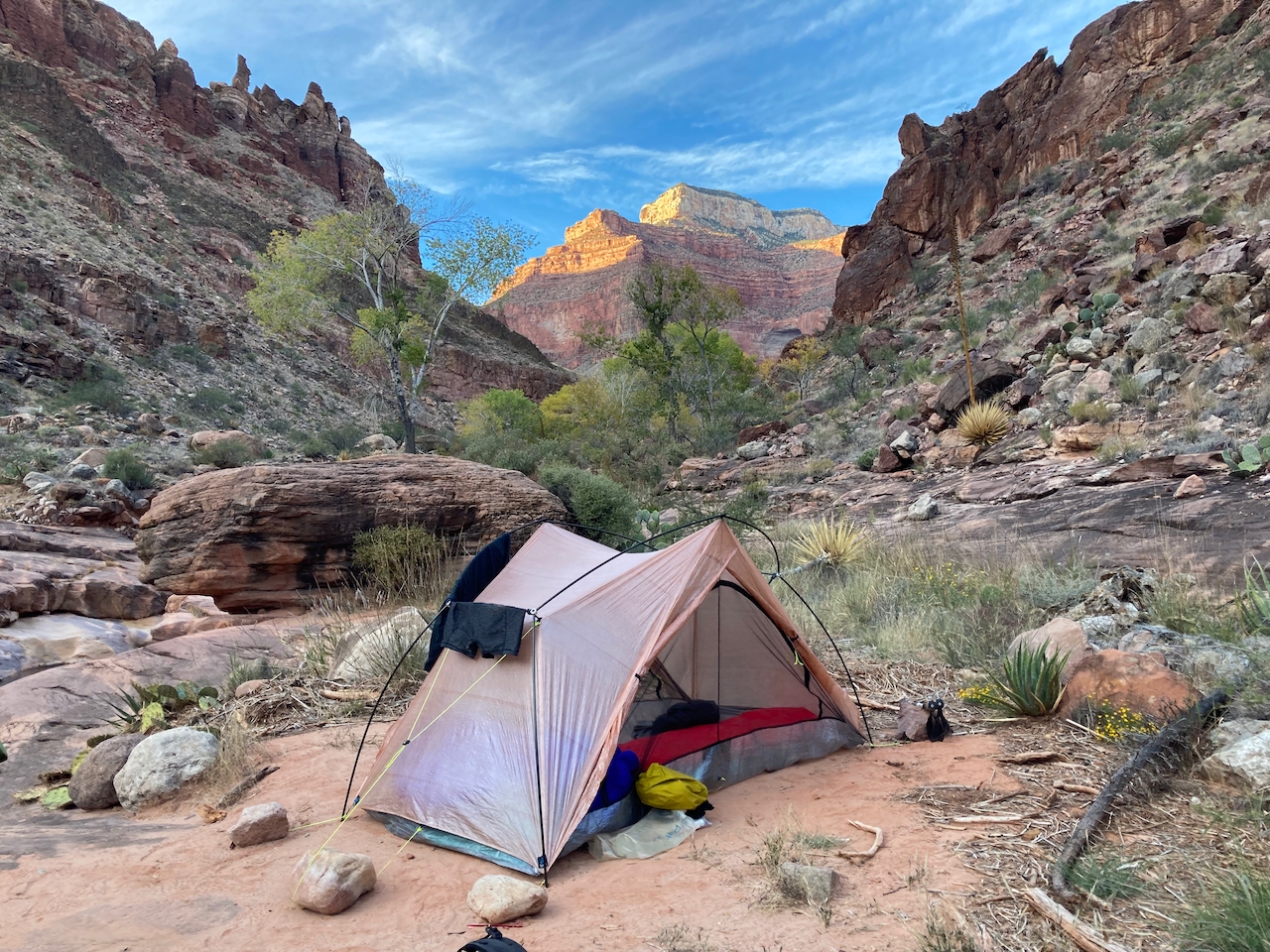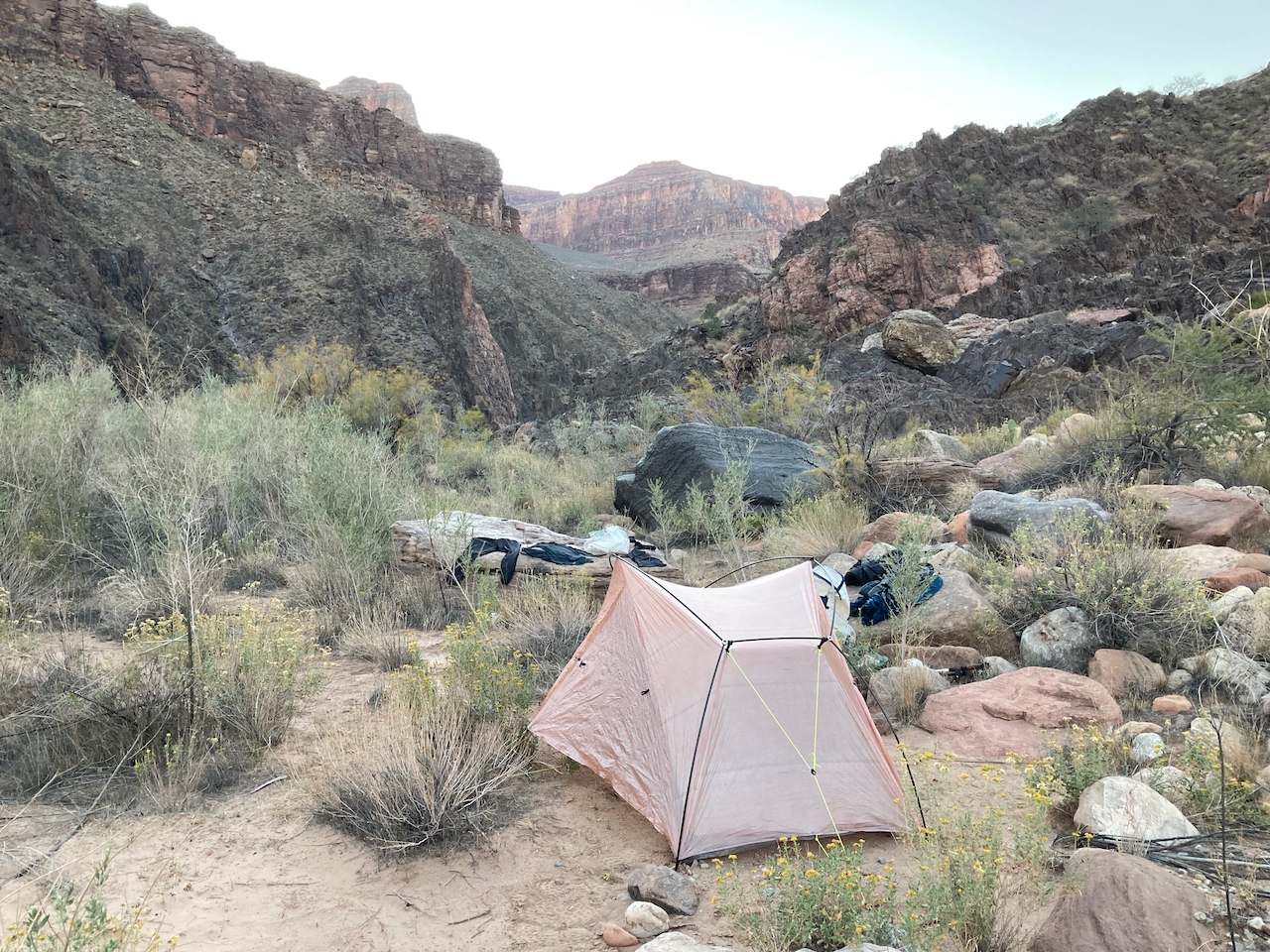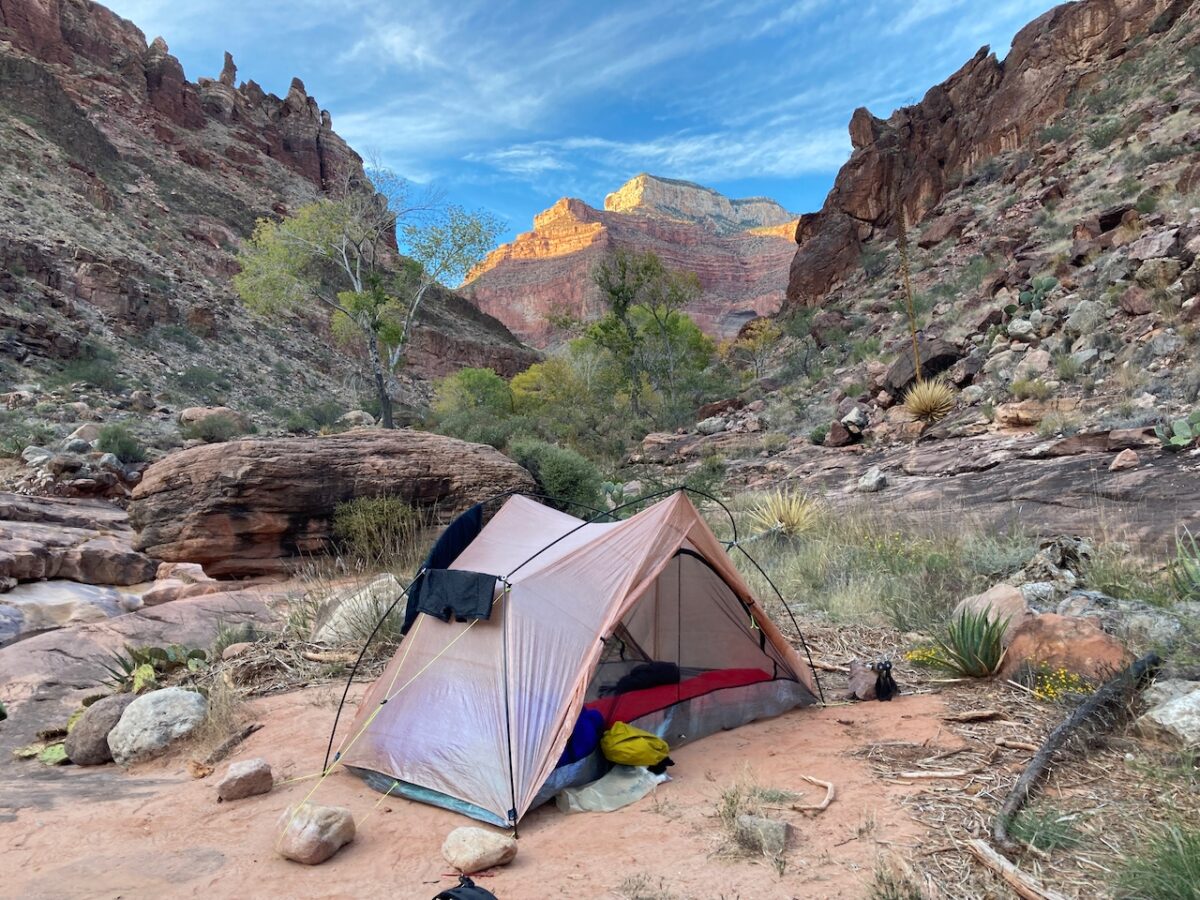Introduction
This Zpacks Free Duo Tent review examines a two-person, two-door, two-vestibule, freestanding, hub-and-pole, single-wall shelter with a tent body constructed of Dyneema Composite Fabric. The Zpacks Free Duo Tent retails for $849 and weighs 30.1 ounces (852 g) including carbon poles.
Zpacks designed The Free Duo Tent for backpackers who camp regularly on surfaces such as sand or rock where stakes are sometimes useless. It may draw the attention of nonfreestanding tent users weary of pounding stakes into rocky, sandy, or frozen soil or current freestanding tent users looking to drop a pound from their current setup.

Highlights
- freestanding (easy to set up in sand or on slickrock)
- no zippers on the fly
- comes in two fabric weights.
- 30.1 oz / 853 g ( in the .55 oz/yd2 DCF)
- 32.1 oz / 910 g (in the 0.75 oz/yd2 DCF)
- more durable than similar weight hub-and-pole tents
- performs well in moderately high wind

Review context
The Zpacks Free Duo is one of a handful of two-door, two-vestibule, hub-and-pole, two-person freestanding tents weighing around two pounds (.9 kg). A few shelters in this category are made from Dyneema Composite Fabric (DCF), such as the Big Agnes Tiger Wall 2 Carbon. A few are made from 7D silnylons, such as the Big Agnes Tiger Wall 2 Platinum.
The Free Duo differs from most tents in this category because it is single-walled instead of double-walled and constructed from more durable fabrics.
Increasing the weight range by about a pound reveals more shelters that could match the Free Duo’s durability at the expense of weight.
These shelters generally cost about half the price of the Zpacks Free Duo. The Big Agnes Copper Spur HV UL2 and the MSR Hubba Hubba 2 are examples of tents in this sub-category. It is hard to say if the Free Duo competes directly with either of these tents. However, it makes sense to imagine a user turned off by the Free Duo’s downsides but who still appreciates the features of tents in this category. In this case, the next logical step is to start looking at something like the Hubba Hubba 2, even though it weighs a pound more.
This article is a Performance Review based on using the Zpacks Free Duo Tent in a variety of environments on several multi-day backpacking trips. Read more about our types of reviews here.

Category overview
In this Zpacks Free Duo review, I will identify the best use-cases for the shelter. I will judge its performance within the category of two-person, two-door, two-vestibule, hub-and-pole shelters instead of comparing it to trekking-pole supported shelters. Rather than spending too much time in the body of the review discussing the relative pros and cons of the category, I would like to take a moment and do that here.
In our archives: read more two-person shelter reviews:
Freestanding and semi-freestanding hub-and-pole shelter pros and cons compared to trekking pole supported shelters
Pros:
- easy to pitch on various unusual surfaces (rock, sand, snow, tent platforms)
- easy to move around or adjust site selection after pitched
- voluminous interiors
Cons:
- expensive
- heavy
- the level of performance in the wind is debatable
- shelter poles are single-use items that take up space in a pack
Features
- two doors
- two vestibules
- hub-and-pole-design
- freestanding
- bathtub floor
- tent stakes needed – 0 stakes needed in calm weather, 2 needed to deploy storm doors, up to 8 in windy weather (stakes not included)
- no tent fly zippers
- very light (for its category)
- stable in the wind
Specifications
- tent: 16.7 oz (473 g) in .55 oz/yd2 DCF or 18.7 oz (531 g) in 0.75 oz/yd2 DCF
- stuff sack: 0.28 oz (8 g)
- tent poles: 12.9 oz (365 g)
- tent pole sack: .21 oz (6 g)
- tent and pole-set weight: 30.1 oz (853 g) in the .55 oz/yd2 DCF and 32.1 oz (910 g) in the 0.75 oz/yd2 DCF
- exterior peak height: 42 in (107 cm)
- ridgeline width: 45 in (114 cm)
- exterior width including vestibules: 75 in (190 cm)
- vestibule space: 15 in (38 cm) depth on each side
- length: 92 in (234 cm)
- interior peak height: 42 in (107 cm)
- floor width: 42 in (107 cm)
- floor length: 90 in (229 cm)
- zipper entry height: 36 in (91 cm)
- packed dimensions: 7 in diameter by 13 in tall (18 cm x 33 cm), 520 cubic inches (8.5 L)
- tent poles (folded, bundled): 2.5 in x 20 in (6 cm x 51 cm)
Materials
- tent body (option 1): .55 oz/yd2 Dyneema Composite Fabric in Blue, Olive Drab, and White
- tent body (option 2): .75 oz/yd2 Dyneema Composite Fabric in Burnt Orange, Dirt, and Spruce Green
- floor: 1 oz/yd2 Dyneema Composite Fabric
- netting: 0.67 oz/yd2 Ultralight Nano-Noseeum
- poles: Easton Carbon 6.3
Performance assessment
Description of field testing
Environmental conditions
- Grand Canyon: clear and dry
- Superstition Wilderness: high humidity with freezing temps and extreme condensation
- Salt Lake City backyard: rain, snow, high winds testing
- Lake Powell area: cold, dry, and occasionally windy
How many user-days?
- about 16
In Our Forums: read a discussion of the Zpacks Free Duo Tent.
List of performance criteria
I reviewed the Zpacks Free Duo based on the following criteria:
- freestanding design / pitching
- fabric
- durability
- weight
- livability
- storm worthiness
- finish quality / aesthetics
- price
Freestanding design / pitching
The Zpacks Free Duo Tent uses a hub-and-pole system of two H-shaped carbon fiber poles, one for each end of the tent. The poles meet each other on each side of the shelter at the center axis but do not connect.

The pole ferrules insert into tiny metal grommets sewn to the corners and peak of the tent. The fabric end panels then snap to the horizontal part of the pole-set with plastic tent-pole clips. I found it easiest to connect these clips to the poles by snapping them to the center of the pole and then sliding the clips horizontally towards the pole hubs. The flexibility of the pole makes this possible. With all the poles in place, the canopy fabric is tight.
Member Exclusive
A Premium or Unlimited Membership* is required to view the rest of this article.
* A Basic Membership is required to view Member Q&A events




Home › Forums › Zpacks Free Duo Tent Review